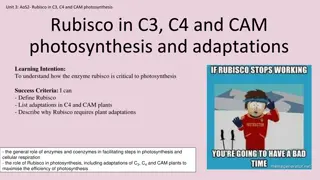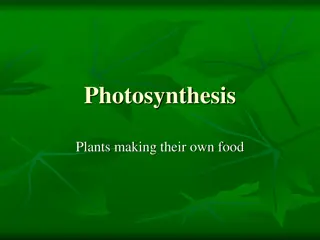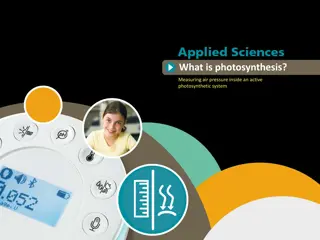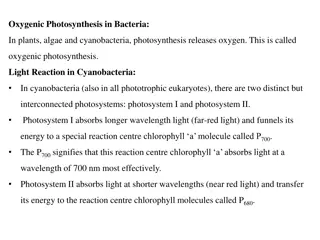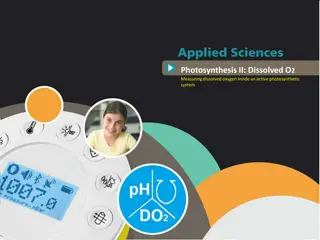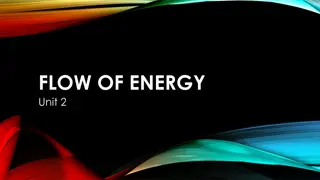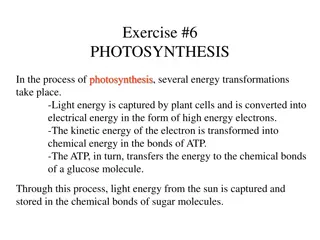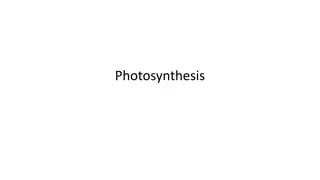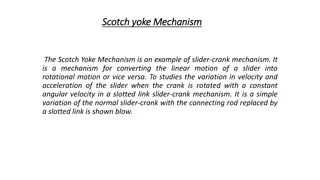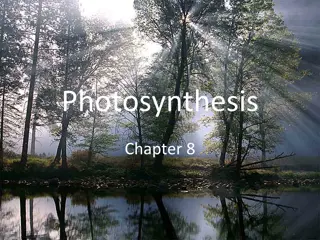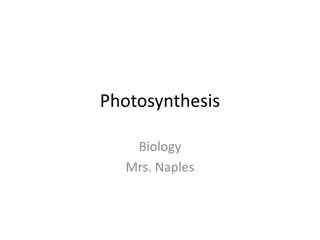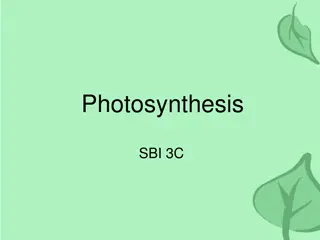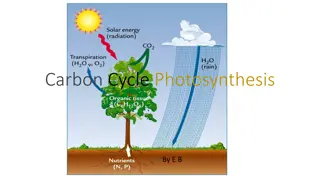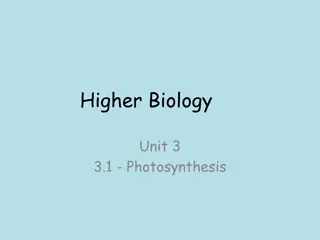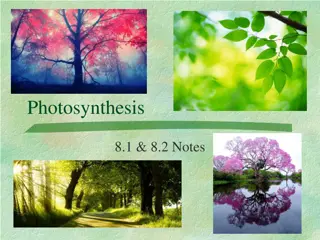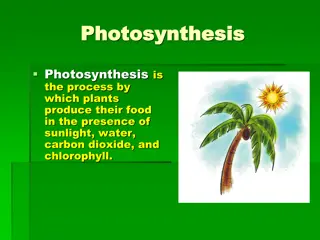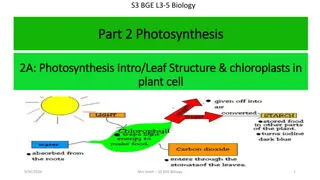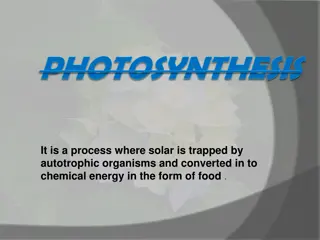Understanding Photosynthesis: The Importance and Mechanism
Photosynthesis is a vital process in plants, utilizing sunlight to produce energy for life on Earth. It occurs in chloroplasts, primarily in leaves, where chlorophyll captures light for the process. The green pigment in plants is due to chloroplasts containing photosynthetic pigments. This process is essential as it provides the energy source for all living organisms. Understanding the location and structure of chloroplasts is key to comprehending the mechanism behind photosynthesis and why plants appear green.
Download Presentation

Please find below an Image/Link to download the presentation.
The content on the website is provided AS IS for your information and personal use only. It may not be sold, licensed, or shared on other websites without obtaining consent from the author. Download presentation by click this link. If you encounter any issues during the download, it is possible that the publisher has removed the file from their server.
E N D
Presentation Transcript
Why Photosynthesis is Why Photosynthesis is Important? Important?
THE SUN: MAIN SOURCE OF ENERGY FOR LIFE ON EARTH
DI MANA TEMPAT TERJADINYA FOTOSINTESIS?
The location and structure of chloroplasts Chloroplast LEAF CROSS SECTION MESOPHYLL CELL LEAF Mesophyll Intermembrane space CHLOROPLAST Outer membrane Granum Inner membrane Grana Stroma Thylakoid compartment Stroma Thylakoid
Photosynthesis occurs in chloroplasts In most plants, photosynthesis occurs primarily in the leaves, in the chloroplasts A chloroplast contains: stroma, a fluid grana, stacks of thylakoids The thylakoids contain chlorophyll Chlorophyll is the green pigment that captures light for photosynthesis
WHY ARE PLANTS GREEN? Plant Cells have Green Chloroplasts The thylakoid membrane of the chloroplast is impregnated with photosynthetic pigments (i.e., chlorophylls, carotenoids).
Electromagnetic Spectrum and Visible Light Gamma rays X-rays UV Infrared & Microwaves Radio waves Visible light Wavelength (nm)
KENAPA DAUN BERWARNA HIJAU? Different wavelengths of visible light are seen by the human eye as different colors. Gamma rays Micro- waves Radio waves X-rays UV Infrared Visible light Wavelength (nm)
THE COLOR OF LIGHT SEEN IS THE COLOR NOT ABSORBED Chloroplasts absorb light energy and convert it to chemical energy Reflected light Light Absorbed light Transmitted light Chloroplast
Chloroplast Pigments Chloroplasts contain several pigments Chlorophyll a Chlorophyll b Carotenoids
Chlorophyll a & b Chl a has a methyl group Chl b has a carbonyl group Porphyrin ring delocalized e- Phytol tail
Different pigments absorb light differently
http://upload.wikimedia.org/wikipedia/commons/thumb/0/0c/Simple_photosynthesis_overview.svg/220px-Simple_photosynthesis_overview.svg.pnghttp://upload.wikimedia.org/wikipedia/commons/thumb/0/0c/Simple_photosynthesis_overview.svg/220px-Simple_photosynthesis_overview.svg.png
THERE ARE TWO PHASES IN PHOTOSYNTHESIS THE LIGHT REACTION H2o is split 2 H2O O2 + 4 [H+] NADPH and ATP are generated THE DARK REACTION NADPH and ATP from the light reaction drives CH2O productionCO2 AND [H+] : (CH2O) + H2O 4 [H+] + CO2 It s really light in-dependent reaction You have already studied it THE CALVIN CYCLE
Cyclic Photophosphorylation Process for ATP generation Reaction Center => 700 nm
Two types of photosystems cooperate in the light reactions ATP mill Water-splitting photosystem NADPH-producing photosystem
Noncyclic Photophosphorylation Photosystem II regains electrons by splitting water, leaving O2 gas as a by-product Primary electron acceptor Primary electron acceptor Photons Energy for synthesis of PHOTOSYSTEM I PHOTOSYSTEM II by chemiosmosis
Plants produce O2 gas by splitting H2O The O2 liberated by photosynthesis is made from the oxygen in water (H+ and e-)
The production of ATP by chemiosmosis in photosynthesis Thylakoid compartment (high H+) Light Light Thylakoid membrane Antenna molecules Stroma (low H+) ELECTRON TRANSPORT CHAIN PHOTOSYSTEM II PHOTOSYSTEM I ATP SYNTHASE
Calvin Cycle Where does the Calvin Cycle occur? In the stroma What goes into the Calvin Cycle? ATP, NADPH, Carbon Dioxide What comes out of the Calvin Cycle? Sugar, ADP, NADP+
each CO2 molecule is attached to a five- carbon sugar, ribulose bisphosphate (RuBP) catalyzed by RuBP carboxylase or rubisco six-carbon intermediate splits in half to form two molecules of 3- phosphoglycerate
reduction of CO2 phase
each 3-phosphoglycerate receives another phosphate group from ATP to form 1,3 bisphosphoglycerate. pair of electrons from NADPH reduces,Gain, each 1,3 bisphosphoglycerate to G3P. Electrons from NADPH change a carboxyl group to a carbonyl group.
regeneration of RuBP phase
regeneration of the CO2 acceptor (RuBP), these five G3P molecules are rearranged to form 3 RuBP molecules. cycle must spend 3 more molecules of ATP (one per RuBP) to complete the cycle and prepare for the next.
Rate of Photosynthesis What is a rate? It is the activity per unit time. What factors can affect the photosynthetic rate?
The Effect of Light Intensity on Photosynthetic Rate
The Effect of Temperature on Photosynthetic Rate
The Effect of Light Intensity and Temperature on Photosynthetic Rate Which is the limiting factor here; light intensity or temp.?
Oxygen Concentration What would a graph for increasing levels of CO2 look like?



